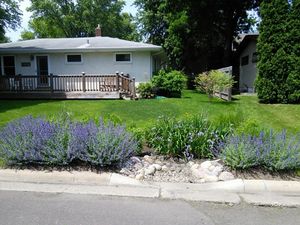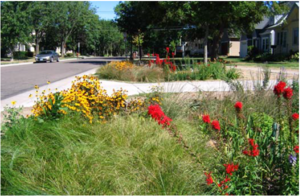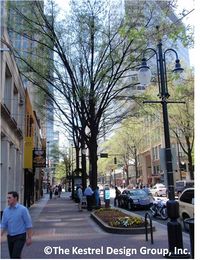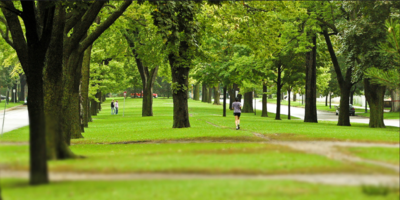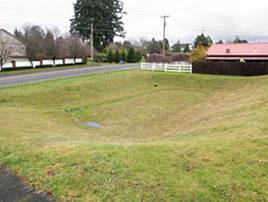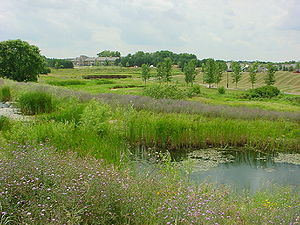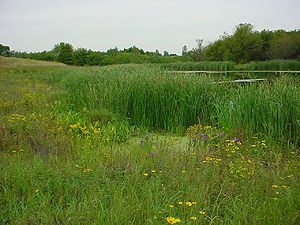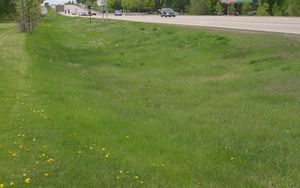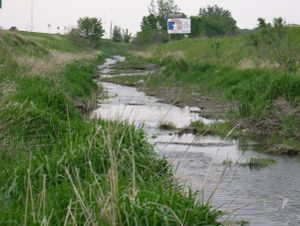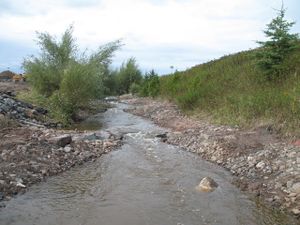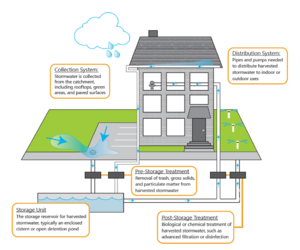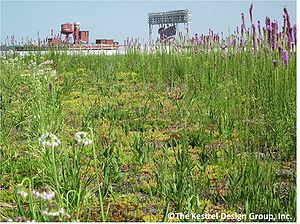
Design considerations for green stormwater infrastructure best management practices
This page summarizes some design considerations when trying to maximize the benefits of green infrastructure practices. The page is organized by individual best management practices.
Contents
Bioretention
Maximizing specific green infrastructure (GI) benefits of bioretention practices requires design considerations prior to constructing the practice. While site limitations cannot always be overcome, the following recommendations maximize the GI benefit of bioretetnion.
- Water quality
- Maximize infiltration by designing with the maximum ponded depth that can be infiltrated in 48 hours, up to 1.5 feet (to protect vegetation). Where space allows, surface area can also be increased. Utilize multiple bioretention practices in series. On lower permeability soils where an underdrain is used, raise the underdrain to the maximum extent possible, allowing water stored in the bioretention media below the underdrain to drain in 48 hours. Use an upturned elbow in underdrained systems.
- For bioinfiltration (bioretention without an underdrain), use a high organic matter media to maximize pollutant removal
- For biofiltration (bioretention with an underdrain), use a media mix that does not export phosphorus or use an amendment to attenuate phosphorus.
- Water quantity/supply
- Maximize infiltration
- Utilize internal water storage
- Maximize water storage in media
- Climate resiliency
- To reduce heat island effects, select vegetation that reflects solar energy, absorbs solar energy and releases it slowly, or that maximizes evapotranspiration NYC Mayor’s Office of Recovery and Resiliency
- Oversize bowl depth (storage) to account for increased precipitation. Winston (2016) recommends oversizing by 33-45% for bioretention in northern Ohio. Oversizing can also be accomplished by reducing loading to individual bioretention practices.
- Establish thicker media depths (Winston (2016) recommends 48 to 102 inches for northern Ohio) to enhance vegetation survival during wet or extended dry periods.
- Utilize internal water storage
- Habitat
- Utilize native, perennial vegetation, including shrubs and trees if space allows. For more information, see Minnesota plant lists.
- Incorporate landscape features, such as form, plant layering, and plant density. For more information on landscape factors, see this presentation by Dr. Steven Rodie (University of Nebraska at Omaha)
- Maximize leaf/plant litter depth and the number of plant taxa
- Consider shape and size to create larger interior habitats
- Evaluate adjacent plant communities for compatibility with proposed bioretention area species. Identify nearby vegetated areas that are dominated by nonnative invasive species.
- Promote soil (media) that maximizes habitat for invertebrate. This includes adjusting pH, limiting the amount of gravel, and promoting development of organic matter. See Kazemi et al. (2009) for more information.
- Community livability
- Choose locations for bioretention that enhance aesthetics
- Choose vegetation that mimics a native landscape, such as tall grass prairie or mixed woodland.
- Evaluate the best placement of vegetation within the bioretention area. Place plants at irregular intervals to replicate a natural setting. Trees should be placed on the perimeter of the area to provide shade and shelter from the wind. Trees and shrubs can be sheltered from damaging flows if they are placed away from the path of the incoming runoff. In cold climates, species that are more tolerant to cold winds, such as evergreens, should be placed in windier areas of the site.
- Health benefits
- Choose locations for bioretention that enhance aesthetics
- Perennial vegetation, particularly shrubs and trees, provide health beenfits related to filtering air pollutants. See The Health Benefits of Trees (Hamblin, 2014)
- Economic benefits
- Choose the correct BMP. There is no comprehensive guidance on this, but an important factor in selecting BMPs is cost per unit treatment. This depends on the goal of the project, but examples of costs may be dollars per cubic foot of water treated or per pound of pollutant. Barr Engineering completed a report that provides information on construction costs, maintenance costs, and land requirements for several stormwater BMPs. The report includes references to other useful reports. Information in the report can be used to match the site goals (e.g. infiltration vs. filtration) and site conditions (e.g. large vs. small site) to the most cost-efficient BMP.
- Factor in all benefits in evaluating the economic value of a BMP or multiple GI practices. For example, appropriate implementation of GI practices can enhance property values. Proper selection of vegetation provides energy savings. Utilizing captured rainwater as an indoor non-potable water source provides savings on energy and water use.
- Utilize multiple properly placed BMPs that work together. For example, permeable pavement can be integrated with bioretention practices to provide an aesthetically pleasing landscape that increases the value of the property while increasing the efficiency of stormwater treatment.
Tree trenches and tree boxes
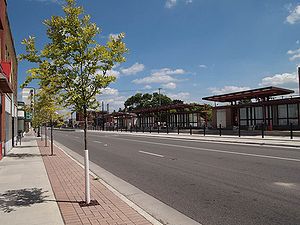
Tree trenches and tree boxes are bioretention practices. Therefore, design considerations to enhance green infrastructure benefits of tree trenches and tree boxes are similar to design considerations for bioretention.
Maximizing specific green infrastructure (GI) benefits requires design considerations prior to constructing the practice. This includes operation and maintenance (O&M) considerations in the design phase. See the supplemental reading list for more information on design, construction, and O&M. While site limitations cannot always be overcome, the following recommendations maximize the GI benefit of bioretention.
- Water quality
- Maximize infiltration by designing with the maximum ponded depth that can be infiltrated in 48 hours, up to 1.5 feet (to protect vegetation). Where space allows, surface area can also be increased.
- Utilize multiple bioretention practices in series.
- On lower permeability soils where an underdrain is used, raise the underdrain to the maximum extent possible, allowing water stored in the engineered media below the underdrain to drain in 48 hours. Use an upturned elbow in underdrained systems.
- For bioinfiltration (bioretention without an underdrain), use a high organic matter media to maximize pollutant removal.
- For biofiltration (bioretention with an underdrain), use a media mix that does not export phosphorus or use an amendment to attenuate phosphorus.
- Water quantity/supply
- Maximize infiltration
- Utilize internal water storage
- Maximize water storage in media
- Energy ([1], [2], [3], [4])
- Select trees based on objectives (e.g. quick-growing or slow-growing, deciduous or coniferous, large or small canopy).
- Plant deciduous trees to shade sun in summer but allow sun to pass through in the winter.
- Select a tree that can be planted within twenty feet of windows and that will grow at least ten feet taller than the window(s). When space permits, use as many trees as needed to create a continuous planting.
- Shade all hard surfaces such as driveways, patios and sidewalks to minimize landscape heat load.
- Place coniferous trees to intercept and slow winter winds, usually on the north side of the building. Do not plant them on the south or west side because this blocks warming sunlight during the winter. These trees also provide some shading benefits during summer.
- Plan on pruning trees to maximize summer shading and to allow sun to enter in the winter.
- Plant trees to shade air conditioners but allow air circulation.
- Use trees as windbreaks, typically on the north and northwest side of the building. Plant your windbreak at a distance from the building of two to five times the mature height of the trees.
- Climate resiliency
- Select species that are more likely to survive in the anticipated future climate.
- Select species that efficiently sequester carbon.
- Ensure trees receive adequate water.
- To reduce heat island effects, select vegetation that reflects solar energy, absorbs solar energy and releases it slowly, or that maximizes evapotranspiration NYC Mayor’s Office of Recovery and Resiliency
- Oversize storage area to account for increased precipitation. Winston (2016) recommends oversizing by 33-45% for bioretention in northern Ohio. Oversizing can also be accomplished by reducing loading to individual bioretention practices. ([5], [6], [7], [8], [9], [10])
- Air quality ([11], [12])
- Park designs that include a variety of land cover—areas of dense trees, scattered trees, and lawn—are likely to provide the greatest opportunities for optimum physical comfort of visitors.
- Increase the number of healthy trees (increases pollution removal)
- Sustain existing tree cover (maintains pollution removal levels)
- Maximize use of low VOC emitting trees (reduces ozone and carbon monoxide formation)
- Sustain large, healthy trees (large trees have the greatest per tree effects)
- Use long-lived trees (reduces long-term pollutant emissions from planting and removal)
- Use low maintenance trees (reduces pollutant emissions from maintenance activities)
- Reduce fossil fuel use in maintaining vegetation (reduces pollutant emissions)
- Plant trees in energy conserving locations (reduces pollutant emissions from power plants)
- Plant trees to shade parked cars (reduces vehicular VOC emissions)
- Habitat
- Utilize native, perennial vegetation, including shrubs and trees if space allows. Select trees for specific habitat characteristics. For more information, see Minnesota plant lists and (Miller (accessed July 6, 2022)).
- Incorporate landscape features, such as form, plant layering, and plant density. For more information on landscape factors, see this presentation by Dr. Steven Rodie (University of Nebraska at Omaha).
- Maximize leaf/plant litter depth and the number of plant taxa.
- Consider shape and size to create larger interior habitats.
- Evaluate adjacent plant communities for compatibility with proposed bioretention area species. Identify nearby vegetated areas that are dominated by nonnative invasive species.
- Promote soil (media) that maximizes habitat for invertebrate. This includes adjusting pH, limiting the amount of gravel, and promoting development of organic matter. See Kazemi et al. (2009) for more information.
- Design tree networks for connectivity, which creates corridors for wildlife, and patches, which mimic small forested areas (Mortberg and Wallentinus, 2000).
- Community livability
- Choose locations for bioretention that enhance aesthetics.
- Choose vegetation that mimics a native landscape, such as tall grass prairie or mixed woodland.
- Evaluate the best placement of vegetation within the bioretention area. Place plants at irregular intervals to replicate a natural setting. Trees should be placed on the perimeter of the area to provide shade and shelter from the wind. Trees and shrubs can be sheltered from damaging flows if they are placed away from the path of the incoming runoff. In cold climates, species that are more tolerant to cold winds, such as evergreens, should be placed in windier areas of the site.
- Health benefits
- Choose locations for bioretention that enhance aesthetics.
- Perennial vegetation, particularly shrubs and trees, provide health benefits related to filtering air pollutants. See The Health Benefits of Trees (Hamblin, 2014).
- Economic benefits
- Choose the correct BMP. There is no comprehensive guidance on this, but an important factor in selecting BMPs is cost per unit treatment. This depends on the goal of the project, but examples of costs may be dollars per cubic foot of water treated or per pound of pollutant. Barr Engineering completed a report that provides information on construction costs, maintenance costs, and land requirements for several stormwater BMPs. The report includes references to other useful reports. Information in the report can be used to match the site goals (e.g. infiltration vs. filtration) and site conditions (e.g. large vs. small site) to the most cost-efficient BMP.
- Factor in all benefits in evaluating the economic value of a BMP or multiple GI practices. For example, appropriate implementation of GI practices can enhance property values. Proper selection of vegetation provides energy savings. Utilizing captured rainwater as an indoor non-potable water source provides savings on energy and water use.
- Utilize multiple properly placed BMPs that work together. For example, permeable pavement can be integrated with tree trenches and tree boxes to provide an aesthetically pleasing landscape that increases the value of the property while increasing the efficiency of stormwater treatment.
Tree ordinances
A tree ordinance is a tool to help protect and manage a community’s trees. It can be designed to regulate various aspects of tree planting, removal, and maintenance on public and private property within a municipality. For more general information on tree ordinances, link here: [13], [14], or [15].
- City of Maplewood, Minnesota
- Lancaster, Pennsylvania
- Dallas, Texas
- Arbor Day Foundation
- Ordinance on vegetation and disease control - City of St. Louis Park
- Ordinance on vegetation and disease control - City of Hayfield
- Model landscape ordinance
Urban forest management master plans
An urban forest master plan provides a road map for managing trees and the tree canopy in an urban area. The master plan typically includes detailed information, recommendations, and resources needed to manage an urban forest. An important component of a good forest master plan is engaging citizens and other stakeholders in the value and care of the urban forest.
A master plan may contain some or all of the following elements.
- Need and authorization, such as the need for ordinances
- Background information, such as historical and current condition of urban forest
- Public participation process
- Urban forest functions and benefits
- Urban forest vision
- Urban forest goals and objectives
- Implementation strategies
- Implementation and phasing
- Monitoring and protection strategy
- Limitations
Example master plans are found at the following links.
- Pittsburgh, Pennsylvania
- Palo Alto, California
- Syracuse, New York
- SanFrancisco, California
- Missoula, Montana
Permeable pavement
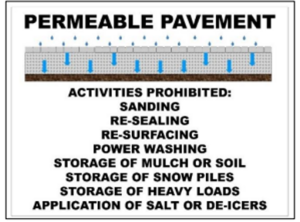

Maximizing specific green infrastructure (GI) benefits of constructed areas requires design considerations prior to installation. While site limitations cannot always be overcome, the following recommendations are given to maximize the GI benefit.
- Water quality and water quantity/hydrology: These benefits are combined since permeable pavement design focuses on infiltration, with the subsoil having less impact on pollutant retention compared to other infiltration practices such as bioinfiltration, where organic matter can be incorporated into the design.
- Ensure the subgrade is flat. Since roads are typically sloped, utilize terracing in the subgrade to achieve flat slopes. See page 5 of the North Carolina design guidance.
- Incorporate signage into the design to ensure maintenance activities do not affect the infiltration properties of the pavement.
- Design to maximize retention time and prevent short-circuiting. Storage may be increased by use of geotextile subgrades. An example is presented by Nnadi et al, (2014).
- Plan for the expected loading on the permeable pavement and ensure capabilities and reduce compaction or clogging
- Use in conjunction with other treatments to establish a treatment train or reuse water on site
- Some research has been conducted into use of geotextiles and other amendments for enhancing water quality treatment. See Ostrom and Davis (2019) and Nnadi et al. (2014).
- Energy:
- If feasible incorporate energy sources into the design, such as solar arrays and ground source heat pump systems
- Climate resiliency:
- Established systems using permeable pavement reduces the runoff impact on surrounding waterways through decreased pollutant loads and increased infiltration
- Permeable pavement systems can be established to support vegetation through water reuse systems, promoting further enhancement of water
- Use light colored pavements to reflect incoming solar energy and reduce heat island effects
- Habitat improvement: Permeable pavement has minimal benefit for habitat but can be combined with vegetated practices. See habitat benefits for bioretention, tree trenches, and swales.
- Community livability:
- When appropriate and feasible, incorporate vegetated practices or harvest and reuse systems (see Beechem et al., 2010) into the design to improve aesthetics and provide additional water quality and quantity benefits.
- Incorporation of vegetation promotes mental health
- Health benefits:
- Choose pavements to maximize traction in cold climates
- Use light colored pavements to reflect incoming solar energy and reduce heat island effects
- Economic benefits and savings:
- Reduction in maintenance cost for vegetation if water reuse system is used in conjunction with permeable pavement
- Integrate vegetation into the landscape design to create habitat, pathways, picnic areas, etc.
Infiltration practices
Maximizing specific green infrastructure (GI) benefits of constructed areas requires design considerations prior to installation. While site limitations cannot always be overcome, the following recommendations for a designer are given to maximize the GI benefit. In addition to the following information, many design considerations applicable to bioretention should be considered for infiltration practices.
- Water quality
- Follow appropriate design guidance to maximize capture of runoff. Consider local climate characteristics (Gonzalez-Meler et al., 2013), which may affect the type and design characteristics of a practice.
- Design infiltration basins to minimize short-circuiting that results in water bypassing the treatment zones in the practice. Deep macropores may lead to short-circuiting but may be desirable for maximizing infiltration volume. If macropore development is encouraged, ensure water preferentially transported vertically receives appropriate treatment by ensuring underlying soils can effectively treat pollutants.
- Infiltration systems with ecological diversity can help promote water quality treatment through effective uptake of pollutants (e.g. nutrients) or through breakdown of pollutants (e.g. promote microbiologic breakdown, such as by ensuring a food source (e.g. organic matter) and oxygenated environment). Diversifying the vegetation will remove a wider range of pollutants and maximize the water treatment
- Ensure adequate pretreatment
- Design the infiltration system to minimize effects of groundwater (e.g. elevated groundwater table), mounding beneath the system, and intersection with underlying sewer systems (Thompson et. al, 2021).
- Water quantity and hydrology:
- Follow appropriate design guidance to maximize capture of runoff. Consider local climate characteristics (Gonzalez-Meler et al., 2013).
- Promoting macropore development results in increased infiltration. Macropores are associated with vegetation and increased invertebrate activity. These can be enhanced through use of deep-rooted perennial vegetation and organic-rich engineered media or soil (Ossola et. al, 2015).
- Distributed infiltration systems throughout an area site typically provide increased hydrologic capacity, partly as a result of reducing the risk and impacts of system failure. One way to increase distribution of infiltration systems is to encourage infiltration on individual parcels (Cadavid and Ando, 2013; Shahzad et al., 2022).
- Maximize water storage by manipulating the media and incorporating internal storage.
- Increase the size of infiltration systems, if feasible, to maximize capture of runoff.
- Climate resiliency:
- To reduce heat island effects, select vegetation that reflects solar energy, absorbs solar energy and releases it slowly, or that maximizes evapotranspiration (NYC Mayor’s Office of Recovery and Resiliency).
- Oversize bowl depth (storage) to account for increased precipitation. Winston (2016) recommends oversizing by 33-45% for bioretention in northern Ohio. Oversizing can also be accomplished by reducing loading to individual bioretention practices.
- Establish thicker media depths (Winston (2016) recommends 48 to 102 inches for northern Ohio) to enhance vegetation survival during wet or extended dry periods.
- Utilize internal water storage
- Select vegetation that can be easily established but also provides potential for carbon sequestration. This includes incorporation of trees and shrubs into the design.
- Habitat improvement:
- Utilize native, perennial vegetation, including shrubs and trees if space allows. For more information, see Minnesota plant lists.
- Incorporate landscape features, such as form, plant layering, and plant density. For more information on landscape factors, see this presentation by Dr. Steven Rodie (University of Nebraska at Omaha)
- Maximize leaf/plant litter depth and the number of plant taxa
- Consider shape and size to create larger interior habitats
- Evaluate adjacent plant communities for compatibility with proposed bioretention area species. Identify nearby vegetated areas that are dominated by nonnative invasive species.
- Promote soil (media) that maximizes habitat for invertebrate. This includes adjusting pH, limiting the amount of gravel, and promoting development of organic matter. See Kazemi et al. (2009) for more information.
- Community livability:
- Include recreational infrastructure and interpretative signs
- Construct the infiltration system in a way that ensures safety and perceived safety of the area. A few examples would be to use shallower infiltration systems to avoid child accidents, attracting pollinators that are appropriate for the nearby community, or planting shrubs, fencing, or vegetation that prevents people from entering the system
- Conduct surveys prior to and after development to identify community desires and construct features that enhance education, recreation, and other benefits of infiltration
- Develop conveyance systems in such a way to minimize changes in temperature that can be detrimental to wildlife such a temperature sensitive fish
- Health benefits:
- Infiltration that incorporates landscaping principles reduce heat stress associate with heat islands (Reducing Urban Heat Islands: Compendium of Strategies - Trees and Vegetation)
- Infiltration that incorporates landscaping principles increases the mental health of the communities that use the area (What are the physical and mental benefits of gardening? Darnton and McGuire, 2014)
- Infiltration systems naturally control mosquito habitats by going dry within a few days compared to stormwater ponds
- Economic benefits and savings:
- Infiltration systems that incorporate desired landscape vegetation may increase property aesthetics and value
- Choose the correct infiltration bmp. This includes both the type of practice (infiltration trench or basin, underground infiltration, bioinfiltration, tree trench, permeable pavement), sizing (multiple smaller practices vs. a larger practice0, and design considerations for the chosen practice. For more information see the design considerations on the following pages.
Constructed wetlands
Maximizing specific green infrastructure (GI) benefits of constructed ponds requires design considerations prior to constructing the practice. While site limitations cannot always be overcome, the following recommendations maximize the GI benefit of constructed ponds.
- Water quality (Balderas-Guzman et al., 2018)
- Distribute constructed wetlands systemically throughout a watershed to increase potential for delivering networked benefits
- Design to maximize retention time and prevent short-circuiting
- Create ecological diversity within the wetland to expose water to a variety of conditions where different treatment processes can take place
- Create shallow zones were water will come into contact with plant roots and microbes and deeper zones where anaerobic processes can take place
- Utilize a length to width ratio of 20:1
- Construct multiple wetland cells
- Ensure adequate pretreatment to minimize pollutant loading that might impair other benefits, such as habitat
- Water quantity/supply
- Distribute constructed wetlands systemically throughout a watershed to increase potential for delivering networked benefits
- Climate resiliency
- Moore and Hunt (2012) determined that most carbon accumulated in constructed wetlands was autochthonous (derived in situ rather than imported). Thus, vegetation establishment is critical to carbon sequestration, with dense emergent communities being favored. Ensure water levels are shallow enough to support emergent macrophytes. Adjustable outlet structures and proper construction and maintenance are tools for ensuring shallow water levels that favor emergent vegetation.
- To avoid or minimize the potential for methane release, construct wetlands to avoid permanent inundation and properly maintain wetlands (Altor and Mitsch, 2006).
- Habitat
- Include a littoral shelf that promotes emergent macrophytes (Moore and Hunt, 2012)
- Vegetative biodiversity may be enhanced by planting littoral areas rather than relying upon natural colonization (Moore and Hunt, 2012)
- Promote a diversity of predators to control mosquito populations (https://onlinelibrary.wiley.com/doi/full/10.1111/j.1936-704X.2010.00389.x Greenway], 2010)
- Community livability
- Maximize the size of wetlands to enhance recreational opportunities (hiking, boating, fishing)(Serrano and DeLorenzo, 2008)
- Couple wetlands with open space to enhance recreation and social activities (Schroeder and Louviere, 1999)
- Include recreational infrastructure and interpretative signs (Greenway, 2010)
- Ensure safety and perceived safety of wetlands and adjacent areas, which typically entails creating more open space and less wooded area (Gobster and Westphal, 2004; Schroeder and Anderson, 1984)
- Conduct surveys prior to and after development to identify features that enhance education, recreation, and other benefits of wetlands
- Health benefits
- See community livability above for recreation opportunities that promote health
- Design wetlands in residential areas for safety. Options include minimizing access for children by planting shorelines to shrubs, fencing specific areas adjacent to the wetland, creating shallow shelves within the wetland to minimize the risk of drowning, properly posting the wetland (particularly in cold climates where the wetland freezes in the winter)(Constructed Wetlands: The Economic Benefits of Runoff Controls National Association of Certified Home Inspectors)
- Minimize mosquito exposure by maximizing open water that allows introduction and maintenance of predator species
- Economic benefits (Constructed Wetlands: The Economic Benefits of Runoff Controls National Association of Certified Home Inspectors)
- Maximize sight-lines to the wetland
- Design wetland for easy access (e.g. locate close to road, create public access)
- Integrate wetland into landscape design, including creating habitat, pathways, picnic areas, etc.
- Create attractive side slopes using vegetation and proper erosion protection
Vegetated swales
Maximizing specific green infrastructure (GI) benefits of vegetated swales requires design considerations prior to constructing the practice. While site limitations cannot always be overcome, the following recommendations maximize the GI benefit of constructed ponds.
- Water quality (Guzman et al., 2018; [16]; [17]).
- If underlying soils are permeable (HSG A or B), incorporate impermeable check dams into the design to promote infiltration. For wet swales incorporate permeable check dams to slow water movement and enhance filtration of solids.
- For infiltration swales (swales without an underdrain), use a high organic matter media to maximize pollutant removal
- Utilize side slopes as pretreatment by incorporating appropriate vegetation and geometry (e.g. dense grass, increased surface roughness, gentler and longer slopes)
- Select vegetation with dense root systems
- For swales (swales with an underdrain), use a media mix that does not export phosphorus or use an amendment to attenuate phosphorus.
- Water quantity/supply
- If underlying soils are permeable, incorporate impermeable check dams into the design to promote infiltration.
- For wet swales incorporate permeable check dams to slow water movement (rate control)
- Climate resiliency
- Promote carbon sequestration by incorporating trees and shrubs when feasible
- Utilize deep-rooted, perennial vegetation to promote carbon sequestration
- Perennial grasses are preferred
- See water quantity/supply above for effects on flood control
- Habitat
- Utilize perennial vegetation that provides habitat benefits, such as food, cover, and pollination potential.
- Utilize a diversity of vegetation, including perennial grasses
- Consider salt tolerance of vegetation when swales are used for conveying water in areas receiving chloride deicer applications
- Community livability
- Choose locations for that enhance aesthetics but provide the conveyance function of swales
- Choose vegetation that mimics a native landscape, such as tall grass prairie or mixed woodland when trees and shrubs can be incorporated into the design
- Evaluate the placement of vegetation within the swale. Place plants at irregular intervals to replicate a natural setting. Trees should be placed on the perimeter of the area to provide shade and shelter from the wind. Trees and shrubs can be sheltered from damaging flows if they are placed away from the conveyance path. In cold climates, species that are more tolerant to cold winds, such as evergreens, should be placed in windier areas of the site.
- Health benefits
- Select vegetation with high evapotranspiration rates to promote cooling
- Economic benefits (Constructed Wetlands: The Economic Benefits of Runoff Controls National Association of Certified Home Inspectors)
- Well-designed swales can increase property values
Harvesting and rainwater/storwater use/reuse
Maximizing specific green infrastructure (GI) benefits of constructed areas requires design considerations prior to installation. While site limitations cannot always be overcome, the following recommendations are given to maximize the GI benefit of water harvesting and reuse.
- Water quality
- The designer should consider the project site pollutant sources during design and determine if additional stormwater treatment measures are required for use, what level of pretreatment is needed, and whether first flush diverters are appropriate. For more information on pollutant sources and pretreatment needs see Water quality considerations for stormwater and rainwater harvest and use/reuse. Also see information on Pretreatment.
- The designer should consider first flush diverters in the collection system design to bypass high pollution loads during snowmelt or pollutant laden events when necessary to meet the requirements of the water use. However, first flush diverters should be utilized with caution ([18]; [19]).
- Designer should place the appropriate settlement and solid removal procedures in the treatment train to prevent their entry into the reuse containment system
- Design the site container to maximize capture and storage of runoff and prevent short-circuiting during rainfall events. See Determining the appropriate storage size for a stormwater and rainwater harvest and use/reuse system and Estimating the water balance for a stormwater and rainwater harvest and use/reuse site.
- Water quantity and hydrology:
- Consider using harvesting on low permeability soils ( hydrologic soil group C and D soils), where captured water can be distributed through irrigation and/or used indoors.
- Size the system to meet the intended uses of the harvest system. This includes ensuring appropriate water supply in response to demand. See Determining the appropriate storage size for a stormwater and rainwater harvest and use/reuse system and Design criteria for stormwater and rainwater harvest and use/reuse.
- Construct the distribution system to reach all areas of the site that require water when economically feasible
- Determine the sites’ water needs for vegetation and plant systems over a given time period and design the water storage container to meet these needs. Typically, harvest systems are designed and built with a specific use and vegetation scheme in mind, but if feasible, consider adopting vegetation to an intended harvest system (i.e. if the objective is driven by performance goals for the harvest system, vegetation considerations should be built into the design considerations).
- Utilize tandem systems which combine multiple storage units, such as multiple rain barrels in sequence (Kwiatkowski, 2012)
- Determine the feasibility of distributed systems, which employs a combination of residential (parcel) harvesting, neighborhood harvesting, and regional harvesting, matching the system to the appropriate storage capacity (Nguyen et al., 2022).
- Climate resiliency:
- Incorporate vegetation into the water reuse system to help remove pollutants and reduce the sites’ carbon footprint
- Establish water reuse systems that will meet the vegetation needs for the site and provide adequate water for growth and maintenance
- Construct the water reuse system in the area best for interception of pollutants
- Habitat improvement:
- When using water reuse systems that will have direct interactions with people, ensure the appropriate treatment techniques are used to meet the necessary water standards
- Rainwater harvest systems can be designed to benefit wildlife. Though many of these designs are for livestock applications, some can be modified for use on individual parcels in urban and semi-urban areas (Texas Cooperative Extension, 2014. Designer should be aware of the wildlife of the area and ensure any treatment measures, especially ones that use chemicals, do not pose a threat to the wildlife and their ecosystem.
- Water reuse systems can establish vegetation that can attract pollinators and promote plant propagation
- Develop conveyance systems in such a way to minimize changes in temperature that can be detrimental to cold water fish habitats. Give particular consideration to runoff from roofs. be aware that water from constructed ponds and wetlands may have elevated temperatures.
- Community livability:
- Include recreational infrastructure and interpretative signs
- Ensure safety of water harvest and reuse systems and adjacent areas by making the storage container inaccessible to unauthorized individuals
- Conduct surveys prior to and after development to identify features that enhance education, recreation, and other benefits of water reuse systems that are desirable to the served customer/community/stakeholder
- Design grown vegetation and plantings with easy access (e.g. locate close to road, create public access)
- Create attractive slopes using vegetation and proper erosion protection
- Health benefits:
- Design storage containment systems for safety. Minimize the depth needed for pooled water if the containing area is exposed. Minimize access to infiltration or other treatment train areas by planting shrubs, fencing, or other area denial systems. Additionally, properly mark the area with signs. Minimizing depth of infiltration systems reduces hazards for children.
- Infiltration systems naturally control mosquito habitats by going dray within a few days compared to typical stormwater ponds
- Economic benefits and savings:
- Maximize sight-lines to the vegetation that the water reuse system services
- Integrating water reuse into landscape design, including creating habitat, pathways, picnic areas, etc can increase property value
Green roofs
Maximizing specific green infrastructure (GI) benefits of green roofs requires design considerations prior to constructing the practice. While site limitations cannot always be overcome, the following recommendations maximize the GI benefit of green roofs. An important design consideration for many green roof benefits is vegetation. For more information, see Plant lists for green roofs.
- Water quality
- Because of low pollutant concentrations, green roofs have limited impact on reducing pollutant loads in stormwater. However, the engineered media for green roofs may leach phosphorus. Low organic matter media, media that does not leach phosphorus (e.g. peat), or amendments (e.g. iron filings) may minimize or eliminate phosphorus losses from green roofs.
- Water quantity/supply (Bollman et al., 2019)
- Increase media depth to extent economically feasible
- Maximize the sorptive and retention properties of the media. Increasing the organic fraction can increase water retention but may result in phosphorus export and other concerns if drying occurs. Additives such as perlite and pumice increase water retention. See Bollman et al., 2019)
- Climate resiliency (Dvorak, 2021; Shafique et al., 2020)
- Select a variety of plants adapted to different microclimates. This increases likelihood that plants will remain established in situations where the climate or microclimate changes. Include at least 15-20 taxa of plants that are native to a variety of microclimate conditions, including a mix of annuals and perennials. Leaf area index is a good indicator of sequestration potential.
- Increase plant diversity, growing a mix of types (e.g. perennials, annuals, bulbs, etc.) and forms (e.g. height, coverage). Include prostrate and upright forms of plants to allow vegetation to compete for its preferred niche on a green roof.
- Utilize nature-based approaches similar to the ecoregion in which the green roof exists
- Incorporate grasses into the landscape as they are deep-rooting and drought tolerant
- Select vegetation that has high root biomass
- Use light-colored mulch to avoid excessive heat gain to the substrate and help retain moisture in the substrate
- If irrigation is used, moisture sensors should be included in zones to help conserve water and prevent overwatering of the substrate.
- Habitat (Dvorak, 2021; Oberndorfer et al., 2007)
- Incorporate annuals into plant selection. Many annuals are important pollinators that can self-sow into bare areas. Since many annuals complete their life-cycle during one season (spring, or summer), it may be necessary to include several species of annuals to have plants actively growing in multiple seasons. Examples include bluebonnets (Lupinus texensis), Indian paintbrush (Castilleja), Firewheel (Gaulliardia pulchella), and black-eyed Susans (Rudbeckia hirta).
- Employ a mixture of small shrubs, grasses, and sedums, each occupying complementary niches.
- Community livability
- Food production can be enhanced by utilizing rooftop greenhouses, which extends the growing season and creates an environment where fertilizer inputs and microclimate can be controlled and the growing season extended (Harada and Whitlow, 2020). Use of potted vegetation also allows for greater control of these factors. Herbs are less dependent on media thickness and are more adaptable to green roof conditions than vegetables.
- Use of a harvest and reuse system (called blue-green roofs) allows for greater control of microclimate factors and can improve food production and plant resiliency (Cristiano et al., 2021).
- Form and function are important considerations for perceptions of green roofs. For example, work buildings can incorporate resting areas for workers, while large buildings can incorporate walkways and lush vegetation (Mesimäkia et al., 2017). End users and their desires should be considered in the green roof design.
- If social interaction is an objective, landscape should be considered. This may include a variety of vegetation of differing heights, including flowering plants (Mesimäkia et al., 2017).
- Health benefits
- Maximize media thickness and select plants that are effective at sequestering pollutants
- Economic benefits (Sailor et al., 2011; Cristiano et al., 2021)
- Increasing media depth and use of light-colored reflective material in areas lacking vegetation results in greater energy savings.
- Captured water may be used to cool and warm buildings.


